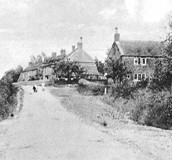
The following items have been provided by my father Hubert Applegate, who spent his teenage years growing up at 3, Bowyers Terrace, Dilton Marsh.
Although the home was situated on Fairwood Road (the Westbury Leigh side of the railway line) Hubert is confident that this was still in the village of Dilton Marsh. The understanding is that the Biss River (or brook) is the dividing line between the two villages.
Charles Case & Sons
The rank of small terrace houses making up Bowyers Terrace are situated on the higher ground overlooking the Tanning Works owned by Charles Case and Sons. This company was involved in the manufacture of high grade leather, mainly for the footware industry. They were probably one of the largest employers in the area from around the late 18th century. A number of his family, including father, grandfather and sisters were employed here.
Imported skins (mainly from India we believe) were processed here using water from the adjacent River Biss. Unfortunately the sometimes overpowering smell from the processing plant and settling ponds was often nearly unbearable, especially on hot summer nights. His father, Walter Valentine, lived at Bowyers Terrace until he died in 1972 at the age of 94.
The Railway
A feature of living at Bowyers Terrace was the Bristol to Southampton railway line which passed just across the road. At that time, Dilton had its own station just a few hundred yards away known as Dilton Marsh Halt . A busy line, it was noted for its steep gradient after leaving Westbury station, so much so that heavy goods trains (often carrying coal from South Wales) needed additional power to get over the gradient. This was provided by an additional engine from the Westbury goods yards pushing from the rear. On reaching Upton Scudamore, beyond Old Dilton, the level gradient allowed the train to roll onto Warminster unassisted.
A unique feature of railways at Dilton Marsh is the physical crossing of two major rail routes, the east/west London to Penzance line passing under the older north/south Bristol to Souhampton line at Penleigh, a hamlet of Dilton Marsh. The actual building of a bridge under the old line used bricks from the local brickworks at Penleigh. Foundation and piers for the bridge were constructed by laying bricks with suitable spacing and then flooding them with hand mixed mortar. This process was repeated until the structure had reached the required height for the iron girders to be put in place. Building of the bridge was around 1928-30.
Brick works at Penleigh
Also off the Fairwood Road, on the other side of the rail line was the local brickworks which were operational through the turn of the century up until at least the 1940s and supplied brick products to the local area for many years. I can remember as a child being taken on a school outing to see the brick works in operation and was amazed at the vast amounts of pure clay that was still being excavated from the site.
Penleigh Flour Seed Mills
Situated on the banks of the Biss at Penleigh with access off of the Fairwood Road was the local Flour mill, using power from the river to turn its mill wheels. My father has living memory of this mill in operation, but further information is lacking
Old Dilton
One of the normal routes to get to Old Dilton from Dilton Marsh was along a lane by the side of Holy Trinity Church. This eventually led onto a steep incline known locally as The Hollow possibly because the hedges on each side were shaped to almost touch overhead giving the impression of a tunnel. At the top, this lane crossed the Westbury to Chapmanslade and Frome road at Hisomley and then proceeded to wind down into the much smaller village of Old Dilton.
Centrepiece of Old Dilton is without doubt the Church of St Mary. Unfortunately, even in my childhood days, the church was little used except on two occasions for the annual harvest festival service in late autumn.and a Christmas carol service
Recollections of the villagers of Old Dilton are dim and not visiting the area too often I can only remember a sprinkling of houses and an isolated farm or two.
Passing through Old Dilton, a road eventually continues on to the village of Upton Scudamore and the supposed source of the River Biss.
Other areas of interest
Readers, especially those who have spent time in the village of Dilton Marsh, may be interested in other local icons around the turn of the 19th century, such as the Greenhouses owned by W.C. Sutton and family who were well known for their production of vegetables and flowers etc under an extensive area of glasshouses. The opportunity to purchase 2nd quality produce at the door was well know to local residents.
The village Post Office managed by Mr & Mrs Forward performed a useful function for the area as did the Garage operated by Mr Shephard in the High Street which dispensed petrol from a hand operated petrol pump for many years. For a number of years my father remembers the local policeman PC Stephens who controlled the area with a high degree of authority and without doubt put many a wayward lad back on the straight and narrow with his own brand of punishment not tolerated today.
Clively
Another small hamlet attached the western end of Dilton Marsh was Clivey. The Applegate family lived here in the early 1900, At least one of my aunties was born here and was known to attend the British School in Dilton Marsh from around 1911
